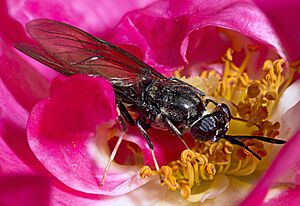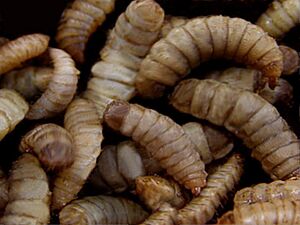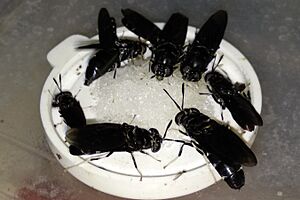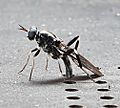Black soldier fly facts for kids
Quick facts for kids Black soldier fly |
|
|---|---|
 |
|
| Hermetia illucens on a rose | |
| Scientific classification | |
| Genus: |
Hermetia
|
| Species: |
illucens
|
| Synonyms | |
The Hermetia illucens, also known as the black soldier fly, is a common fly found all over the world. Since the late 1900s, this fly has become very important. It helps us recycle organic waste and create food for animals.
Contents
- Where Black Soldier Flies Live
- What Black Soldier Flies Look Like
- The Black Soldier Fly Life Cycle
- How Black Soldier Flies Help Humans
- Possible Natural Enemies
- See also
- Images for kids
Where Black Soldier Flies Live

Black soldier flies first came from warmer parts of America. But in recent years, they have spread to almost every continent. You can find them in North America, Europe (like Spain, France, Italy), Africa, Australia, and Asia. They are truly global travelers!
What Black Soldier Flies Look Like
Adult black soldier flies are about 16 millimeters (0.6 inches) long. They are mostly black. Their bodies can have shiny blue or green colors, especially on their middle section (thorax). Sometimes, the end of their body (abdomen) is reddish.
They have clear spots on their second body segment. These spots are why they are called "illucens," which means "shining through" in Latin. Their heads are wide, and their eyes are very big. Their antennae (feelers) are about twice as long as their head. Their legs are black with light-colored feet. When they rest, their wings fold flat over their body.
Black soldier flies are amazing at mimicry. This means they look like other animals to protect themselves. They look a lot like the organ pipe mud dauber wasp. They have long antennae like wasps. Their back feet are pale, just like the wasp's. They also have two small, clear "windows" on their body. These make them look like they have a narrow "wasp waist."
You can tell black soldier fly larvae (young flies) apart from other fly larvae. They have a thin gray-black stripe at their back end.
The Black Soldier Fly Life Cycle
A female black soldier fly lays about 200 to 600 eggs at once. She usually lays them in cracks or on surfaces near rotting things, like compost. The eggs hatch in about 4 days.
When they first hatch, the larvae are tiny, about 1 millimeter (0.04 inches) long. They can grow to be about 2.5 centimeters (1 inch) long. They can also weigh up to 0.22 grams (3.4 grains) by the end of their larval stage. These larvae can eat many different types of organic matter. They can adjust to foods with different nutrients.
The larval stage lasts from 18 to 36 days. This depends on the food they eat. The last part of this stage, called the "prepupal" stage, lasts about 7 days. If it's cold or there's not enough food, the larval stage can last for months.
After the prepupal stage, they become pupae. This stage lasts 1 to 2 weeks. Adult flies can live for 47 to 73 days if they have water and food like sugar or nectar. If they only have water, they can live for about 8 to 10 days using fat they stored as larvae.
How Black Soldier Flies Help Humans
Black soldier fly larvae and adults are not considered pests. They don't spread diseases. Instead, they are like redworms. They are important decomposers. This means they break down organic materials and return nutrients to the soil.
The larvae are very hungry! They can be used for composting food scraps from homes and farms.
Also, black soldier fly larvae are a good source of protein. They are used to feed fish, chickens, pigs, lizards, and even dogs. Companies around the world now raise these insects in large "insect factories" to make animal feed.
As Decomposers and in Composting
Black soldier fly larvae (BSFL) are used to compost waste or turn it into animal feed. This waste includes fresh manure and food scraps from both plants and animals. These fly larvae are very good at turning waste into useful feed.
When the larvae are fully grown, they become "prepupae." At this point, they stop eating. They tend to move towards cool, dark, and dry places to become pupae. This natural movement helps people collect them easily. Special composting bins have ramps or holes. These let the prepupae crawl out and fall into a collection area.
Here are some ways larvae are helpful:
- They are much bigger than houseflies or blowflies. This allows BSFL to stop other flies from laying eggs in decaying matter. Compost systems with houseflies smell much worse than those with BSFL. This makes H. illucens a better way to handle food waste.
- They are not pests to humans. Adult black soldier flies have small mouthparts. They can only drink liquids like flower nectar or not eat at all. They don't spit up food like houseflies, so they don't spread diseases.
- They are not attracted to human homes or food. Female flies are drawn to rotting food or manure to lay eggs.
- Black soldier flies do not fly around as much as houseflies. They have less energy because they can't eat much as adults. They are easy to catch if they get inside a house. They don't try to get away, they are clean, and they don't bite or sting.
- They can greatly reduce harmful bacteria like E. coli and Salmonella in chicken manure.
- They quickly clean up pollutants. Nine types of organic chemicals were greatly reduced or removed from manure in just 24 hours.
- They quickly reduce the amount and weight of waste. The larvae break apart and mix their food. They also create heat, which helps the compost dry out. They can reduce the volume of compost by about 50%.
Besides making protein, fly larvae also produce a valuable material called frass. Frass is a dry, odorless leftover that can be used as organic fertilizer. It can also be used by earthworms.
New research shows these insects can even help clean up biomass (plant material) that has heavy metals in it. This process is called entomoremediation.
As Animal Feed
Black soldier fly larvae are used as feed for animals. The harvested pupae and prepupae are eaten by chickens, fish, pigs, lizards, turtles, and even dogs. This insect is one of the few approved for use as feed in fish farms in the European Union.
At the pupal stage, black soldier flies have the most nutrients. They can be stored at room temperature for several weeks. They last longest when kept at 10 to 16 degrees Celsius (50 to 60 degrees Fahrenheit).
As Human Food
It's hard to find old records of humans eating H. illucens.
In 2013, a designer named Katharina Unger created a small insect farm for homes. It's called "Farm 432." People can use it to grow edible fly larvae at home. This machine can produce 500 grams (1.1 pounds) of larvae, or two meals, in a week.
People say the larvae have a unique taste. Unger described them: "When you cook them, they smell a bit like cooked potatoes. They are a bit firm on the outside and soft like meat inside. The taste is nutty and a bit meaty."
For Producing Grease
BSFL can be used to make grease. This grease can be used in the pharmaceutical industry for things like cosmetics or shower gel. It can replace other plant oils, like palm oil. It can also be used in animal feed.
For Producing Chitin
BSFL can also be used to produce chitin. Chitin is used in shipping to prevent things from growing on ships. It's also used to clean water. Chitin can also improve soil fertility and help plants grow stronger.
For Producing Organic Plant Fertilizer
The leftovers from the larvae's eating process are called frass. Frass includes larval waste, shed skins, and undigested food. Frass is a main product from raising black soldier flies.
The exact makeup of frass changes depending on what the larvae eat. But generally, it's a great organic fertilizer. It has a good balance of important plant nutrients: nitrogen, phosphorus, and potassium. Frass is usually mixed directly into the soil. It releases nutrients slowly over time. However, some studies show it can also work quickly, like fast-acting chemical fertilizers.
Besides nutrients, frass can have other good things for soil health. One of these is chitin, which comes from the larvae's shed skins. Frass can also change the types of microbes in the soil. This is very important for healthy soil.
There is some discussion about whether frass should be used fresh or composted further. Some think composting reduces any harmful effects on plants. In the European Union, insect frass must be heated to 70 degrees Celsius (158 degrees Fahrenheit) for one hour before being sold. This is for safety reasons, similar to animal manure.
In Bioremediation
The larvae of H. illucens have been used in experiments to clean up polluted areas. This is called bioremediation. In one test, they ate up to 49% of dry corn leaves that were polluted with cadmium or zinc in 36 days. This was a better result than composting. Cadmium mostly built up in the pupa's shell. Zinc mostly built up in the adult fly. Using insects for this cleanup is called entomoremediation.
Potential Source of Plastic-Degrading Enzymes
Scientists think that the bacteria in the gut of H. illucens larvae might be a good source for finding enzymes and microbes that can break down plastic.
Potential Use in Biodiesel Production
H. illucens could also be a good source for making biodiesel.
Farming Black Soldier Flies
Larval Colonies
The biggest challenge in farming black soldier flies is getting enough larvae or eggs to start or keep a colony going. Farmers usually get flies to lay eggs in small holes above their grub bins. Adult flies lay groups of eggs in the edges of corrugated cardboard or plastic.
In warm climates, they might breed all year. In cooler places, a greenhouse might be needed to get eggs during colder times. The grubs are very tough. They can handle more acidic conditions and higher temperatures than redworms. Larvae can survive cold winters, especially if there are many of them, or if the compost pile creates heat.
Heat helps the grubs crawl off, become pupae, and hatch. A lot of light and heat seem to be needed for breeding. Many small-scale farmers start their colonies from eggs laid by wild black soldier flies.
Space and Shape
Newly hatched soldier flies start their mating dance in the air. The male grabs the female, then connects with her. They mate while staying still and connected.
German scientists have successfully bred soldier flies in a space as small as 10 liters (about 2.6 gallons).
Heat for Breeding
Adult flies usually mate and lay eggs at temperatures of 24 to 40 degrees Celsius (75 to 104 degrees Fahrenheit) or more. About 99.6% of egg-laying in nature happened between 27.5 and 37.5 degrees Celsius (81.5 and 99.5 degrees Fahrenheit).
Light for Breeding
Special lamps have been used to help adults mate. Mating success can be greatly increased by using light that has a lot of blue (around 440 nm) and/or green (around 540 nm) wavelengths. This light should be as bright as a good amount of sunlight. In tropical areas, direct morning sunlight is best for flies to emerge, mate, and lay eggs. Indirect sunlight is often preferred before and after mating.
Humidity for Breeding
A humidity level of 70% is considered best for all stages of their life cycle.
It was found that the larvae don't need a special material to pupate. But this material is thought to help control humidity, stopping them from drying out. A 93% hatching rate was seen when humidity was kept at 70%.
Black Soldier Fly Larvae and Redworms
People who farm redworms often find black soldier fly larvae in their worm bins. Larvae are best at quickly turning "high-nutrient" waste into animal feed. Redworms are better at turning materials high in cellulose (like paper, cardboard, leaves, and most plant materials) into great soil amendment.
Redworms can live on the leftovers produced by fly larvae. However, the liquid (called "tea") from larvae can be too acidic for worms. The larvae's activity can keep temperatures around 37 degrees Celsius (98.6 degrees Fahrenheit), but redworms need cooler temperatures. Most attempts to raise many larvae and redworms in the same container at the same time don't work well. Worms can survive under grub bins if the bottom is on the ground. Worms can also live in grub bins when there aren't many larvae, like in the cold season.
As a feeder species, BSFL are not known to carry parasitic worms that infect chickens. Redworms, however, can carry many such parasites.
Names and Trademarks
Black soldier fly larvae were first developed as food for exotic pets by D. Craig Sheppard. He called the larvae Phoenix Worms and started selling them as pet food. In 2006, Phoenix Worms became the first feeder insect to get a U.S. registered trademark.
Other companies also sell BSFL under different names. These include NutriGrubs, Soldier Grubs, Reptiworms, Calciworms, BIOgrubs, and Obie's Worms (in Canada). In Africa, they are sold as live feeders, meal, and oil by ProtiCycle. They are used for animal feed, pet food for dogs and cats, and food for fish like tilapia and catfish.
Possible Natural Enemies
In West Africa, a tiny wasp called Dirhinus giffardii has been found to be a parasitoid of H. illucens pupae. This wasp can reduce the number of eggs laid by the flies. It has been found to reduce fly populations by up to 72%. These wasps carry the parasite, so steps should be taken to protect the larvae from them. Another wasp, Eniacomorpha hermetiae, has also been found to be a parasitoid of H. illucens. This can negatively affect efforts to raise many black soldier flies in Africa.
See also
 In Spanish: Hermetia illucens para niños
In Spanish: Hermetia illucens para niños
- Black fly
- Insect farming
- Insects as feed
Images for kids
-
A black soldier fly on a crape jasmine leaf, in West Bengal, India
















